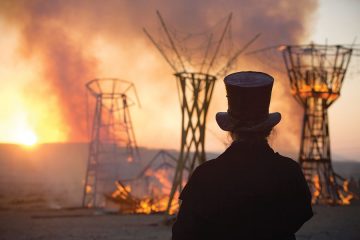Why to You Should Watch More Mainstream Asian Films
Guest post by Peter Wong
Why should you watch the more commercial Asian films? Let’s paint some word pictures:
*Because you’ll see some terrified passengers crawl along the car’s luggage rack to avoid the zombies which have packed a train’s passenger car (“Train To Busan”).
*Hong Kong action cinema legend Chow Yun-Fat demonstrates in the same movie that he can be both an asshole art critic and a very cool boss who fires two assault rifles simultaneously (“Project Gutenberg”).
*A teenage girl becomes a singing superstar while hiding her face in her YouTube videos (“Secret Superstar”).
*During a high speed car chase down an alley, the occupants of the pursuing and pursued cars are shooting at each other. In a next level moment, one car flips over and lands on the other car’s roof. The cars haven’t stopped moving…and each car’s occupants are continuing to shoot through the car roofs at each other. (“Operation Red Sea”).
*A simple welder invents a machine that can produce female sanitary napkins cheaply for his rural village and becomes a real-life superhero. (“Padman”).
*A medieval era tale of mystery and political intrigue climaxes with a giant white ape duking it out with a skyscraper tall monster which has a hundred eyes (“Detective Dee: The Four Heavenly Kings”).
Admittedly, most Asian commercial films don’t reach the levels of craziness or unusual drama as the films mentioned above. But enough of them actually do reach such entertaining madness levels that catching these films when they hit a local theater is a must.
But why theatrical screenings, you may ask. Why not wait for some streaming service to acquire an Asian commercial film, like Netflix did for the fantastic Indonesian action film “Headshot?”
If you’re reading this on Broke-Ass Stuart’s website, then you’ve got your answer. The San Francisco Bay Area does have multi-screen facilities showing just the same half-a-dozen Hollywood blockbusters. But some of those same multiplexes also make room for one or two pop films from Asian countries. In addition, there are small indie theaters which can be way more adventurous with the type of Asian films they program for short runs. Further, you might be lucky and discover the original version of a great Asian pop film before Hollywood remakes it badly. Finally, there’s something to be said for sharing an auditorium of people who share the same interest you do in live action Asian film. You live here, why not take advantage of it?
To help you get started exploring the world of Asian commercial film, here are answers to some FAQs.
Question 1: Where do these films come from?
The Asian commercial films usually seen in San Francisco Bay Area theaters hail from a small handful of countries or regions. They are: Hong Kong, Mainland China, South Korea, Japan, India, and the Philippines. These countries boast a strong filmmaking industry and occasionally produce films considered commercial enough to be brought to American theatres. American audiences would not have learned about Indonesian martial artist Iko Uwais had both “The Raid” movies not been brought to American film screens.
Question 2: Do all commercial Asian films have martial arts fights, gunfights, lots of singing, or all of the above?
Short answer: Hell, no.
Longer answer: It depends on what type of Asian film you’re interested in catching.
The Philippine films that usually show up in Bay Area theaters tend to be dramatic or comic love stories. But not always. “Ang Larawan” adapted a famous stage play about two financially struggling sisters torn between selling or keeping what may be their artist father’s last painting. Action drama “Buybust” tells the story of two cops who must fight their way out of a slum after a drug bust operation goes spectacularly wrong.
Because of anime’s popularity in America, animated Japanese films appear more frequently in theaters than do live action Japanese films. From known franchises like “Dragonball” to original films such as “Mirai,” the offerings are usually genre fantasy or science fiction. Yet there’s room for the occasional curve ball such as the partying hearty college girl tale “The Night Is Short, Walk On Girl.”
But finding more recent live action Japanese films has become a bit harder. The new Hirokazu Kore-eda film “Shoplifters” may be wowing both critics and American audiences. But cult director Takashi Miike’s 100th film, “Blade Of The Immortal,” quickly disappeared from local theatres despite being a manga adaptation which mixed samurai action with body horror. Also, nobody has yet come forward to give the making a zombie movie comedy “One Cut of the Dead” anything approaching a decent American theatrical release.
Korean live-action films shown locally generally fall into the genre category. There have been fantasies of the afterlife (“Along With The Gods: The Two Worlds”), historical action films (“Musa: The Warrior”), and even a Korean remake of Johnnie To’s “Drug War” (“Believer”). But there have also been 1920s-era spy dramas (“The Age Of Shadows”), disaster movies (“Tunnel”), and a violent female assassin revenge thriller (“The Villainess”).
Chinese films generally refer to anything from art to genre films hailing from the Mainland and Hong Kong. On the art film extreme you have directors such as Jia Zhangke, whose films have dealt with everything from China’s 1980s social changes (“Platform”) to a tale of a woman’s empowerment in 21st century China (“Ash Is Purest White”). (Coincidentally, Jia Zhangke is making a rare Bay Area public appearance on February 8 and 10, 2019 at the Pacific Film Archive.) On the other extreme, more crowd-pleasing directors such as Johnnie To, Tsui Hark, and Dante Lam have done everything from special effects laden extravaganzas (“Journey To The West: The Demons Strike Back”) to Chinese versions of a Michael Bay movie (“Operation Red Sea”) to even a musical about office politics (“Office”).
Bollywood films screened in the Bay Area also offer everything from contemporary comedy to historical drama to even crime action. The musicals, in particular, can run up to three hours but there’s an intermission to allow viewers to stretch their legs. “Raees” sees cinematic romantic heartthrob Shah Rukh Khan play a town’s top bootlegger who grows up to become an antagonist of the town’s corrupt politicos. In “102 Not Out,” legendary actor Amitabh Bachchan tries to become the oldest man in the world while also teaching his 75-year-old son to enjoy life again. “Thugs Of Hindostan” offers an Indian take on the “Pirates of the Caribbean” franchise, where a band of 18th century Indian pirates harass British colonizer jerks. “Lagaan,” another Indians vs. British colonizer jerks story, is a must-see about a poor Indian village trying to settle a tax debt by playing a cricket game…a game the villagers have never played before. And of course, there are the hilariously trashy “Dhoom” movies.
To proverbially dip your toe into Asian film, see if an Asian film you’re curious about has a trailer on YouTube. Quite a few films do, even if not all of these trailers are subtitled.
Question 3: Where can I find theatrical screenings of such films?
The answer is, it depends on how far you’re willing to travel and for what.
In San Francisco, your best bet is the AMC Metreon 16, which usually screens one or two Chinese or Korean films weekly.
The Century San Francisco Centre 9 will show an occasional Bollywood film. If not, try the Century 20 Daly City. Around Diwali, two Bollywood blockbusters will be shown in the Century Theaters. Alternately, one Diwali blockbuster will be shown at a Century theater while the other screens at one of the local AMC theaters.
San Francisco’s 4-Star Theatre can be counted on to show both pop Asian films and more arty fare. The Tsui Hark action film “The Taking Of Tiger Mountain” has graced its screens. But it’s also shown the Chinese sexual harassment drama “Angels Wear White” and the Nepalese drama “White Sun.” The theatre also hosts an annual China film festival.
The AMC Mercado 20 in Santa Clara offers the most first-run Asian films. In one week, the theater offered “Project Gutenberg,” three Bollywood films, a Korean drama, and another Chinese drama.
Pilipino films will play at either the Century At Tanforan or the Century 20 Daly City. As mentioned above, you’ll usually be getting a romantic comedy or drama or a combination of the two.
San Francisco Japantown’s New People Cinema, when it’s not being used as a film festival venue, does one day only film screenings of Japanese films on the weekends. A recent slate of screenings included two anime feature films and an encore of “One Cut Of The Dead.”
Berkeley’s Pacific Film Archive can always be counted on to screen older (and newer) live action films from Japan (and other Asian countries). The Archive recently finished screening a Japanese film classics series which included such titles as “Sansho the Bailiff,” “Double Suicide,” and “Early Summer.”
San Francisco’s Roxie Theatre also screens a variety of Asian films old and new. Anime feature films have become a reliable staple. Their Nippon Nights film series offers a monthly showcase for Japanese films ranging from the violent Sion Sono cult film “Suicide Club” to the monster movie psychodrama “Goke, Body Snatcher From Hell.” A recent schedule featured a classic “Lone Wolf & Cub” samurai action film and the acclaimed documentary “The People’s Republic Of Desire.”
Falling into the category of new Asian cinema long-shots are the Rialto Cinema Elmwood, the Alamo Drafthouse Cinemas, and the Landmark Theatres chain. These venues rarely screen Asian films. On the other hand, the Elmwood provided “Train To Busan‘s” sole theatrical screenings. “Your Name” had been enjoyed in the comfort of the Alamo Drafthouse. Hirokazu Kore-eda’s acclaimed “Shoplifters” started its Bay Area theatrical run at a Landmark Theatre venue.
IV. Last Words
The sheer variety of Asian films and the range of genres employed means the persistent and curious will eventually find something that will excite them enough to even share with friends. Cut out the crappy Hollywood remake middleman and catch an original Asian film now.
















